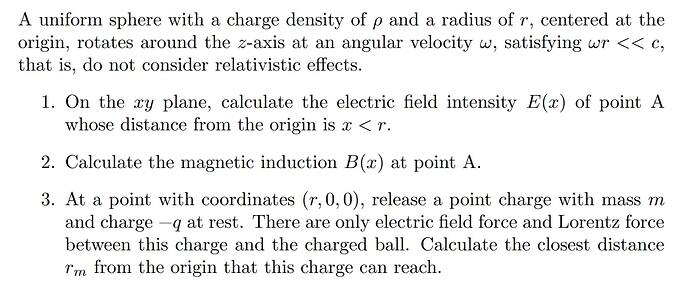Please help in this problem. I am unable to solve the 3 parts. Please provide a difficulty rating for this as well, if possible.
Normally, I would calculate B(x) through calculating the magnetic dipole moment, but the x<r condition makes me doubt about it. Calculating through Biot-Savart law would be kinda messy too.
yeah… I have no ideas…
Maybe we can use the electromagnetic field transformation? In the rotating frame of reference where the sphere is at rest, \vec B'=0 and \vec E' = \vec E. The fields \vec E and \vec B in lab frame and \vec E' and \vec B' in rotating frame have the following non-relativistic relations:
So if we take \vec V=\vec\omega\times\vec x=\omega x\hat y, and \displaystyle\vec E'=\frac{\rho x}{3\varepsilon_0}\hat x, then
I didn’t try to use this method before, so I’ll try to apply this algorithm to some other well-known problems to see whether this answer is true or not.
It seems like the solution is wrong, as these transformation formulas are for the inertial frames of reference, and the rotating frame is not inertial.
oh i see
any progress, bro?
Dude, I tried to use Biot-Savart law yesterday, but integration by r via online calculator gave me this:
I have almost no idea about calculating \vec B .-.
Broooooooo… ![]()
![]()
![]()
![]()
Does this require some special technique we might not know??
So here’s my attempt to find a solution through vector potential (thanks to @Ersultan for this idea):
We need to use Maxwell’s equation
where \vec j=\rho\vec v=\rho(\vec\omega\times\vec r)=\mu_0\rho\omega r\sin\theta\hat\varphi. So consider a vector field, the curl of which is a magnetic induction field, \vec B = \nabla\times\vec A. The \vec A is a vector potential, which I will be calculating there.
The convenience of this method is that we can use the spherical symmetry around the z-axis. I mean, if you know the Biot-Savart law for the vector potential
you can see that it is collinear to \vec j if the direction of the latter is constant. Then apparently, in a rotating sphere, the \vec A field makes concentric circles around the z-axis and is collinear to \hat\varphi. Knowing that
let’s find a solution in \vec A = F(r)\sin\theta\cdot\hat\varphi form.
Using
(this thing gets very simple in our case because A_r=A_\theta=0 and |\vec A| doesn’t depend on \varphi.)
we get
Now let’s take the curl again, using \displaystyle (B_r, B_\theta, B_\varphi)=\left(\frac{2F\cos\theta}{r},-\frac{\sin\theta}{r}\frac{\partial}{\partial r}(rF),0\right) (their derivatives with respect to \varphi is zero):
As now you see, this thing is proportional to \sin\theta, so we made our assumption about A(r,\theta) right. Next we have to solve a second order differential equation:
Using variation of parameters, one can get
So, C_2=0 because infinite F(0) (which corresponds to infinite B) makes no sense. And FINALLY the vector potential takes its form as
and the magnetic field is
and in our B(x, 0, 0) case (r=x, \theta =\pi/2, so \hat\theta=-\hat z):
Now, there are different approaches to finding C. We can manually find the \vec B at the origin, for instance. It equals to
Hence, 2C = \displaystyle\frac{1}{3}\mu_0\rho\omega R^2. So…
The answer is
Note that this answer is also consistent with the x=R case. As you remember from the general solution for \vec A,
For the |\vec r|>R case, \rho=0, C_1=0 (because |\vec A| is zero on infinity). What we now have is that outside of the sphere, the system acts like a dipole \vec m =\displaystyle\frac{4\pi\rho\omega R^5}{15}\hat z, even when the distances are not significantly greater than R. Anyway, the vector potential produced by this dipole equals
So comparing with the general solution gives \displaystyle C_2=\frac{\mu_0\rho\omega R^5}{15}, so \vec B=\nabla\times\left(\displaystyle\frac{C_2}{r^2}\sin\theta\cdot\hat\varphi\right)\Bigg|_{x=R}=\displaystyle-\frac{\mu_0\rho\omega R^2}{15}\hat z is again constistent with the particular x=R case of the \vec B(x<R) equation.
thanks man
where would you rate the difficulty of the problem? and plz provide a sol for 3rd part
I was told that this problem is originally Chinese, and I think the 2nd part requires skills that are out of the IPhO syllabus (or there may be a slick solution, idk).
I’m sure you can do the rest on your own bcz the rest of the problem is simply a charge’s motion in the EM-field in the xy-plane. Though it’s mostly mathematics, Morin’s classical mechanics book would be helpful there.
ok thanks a ton
